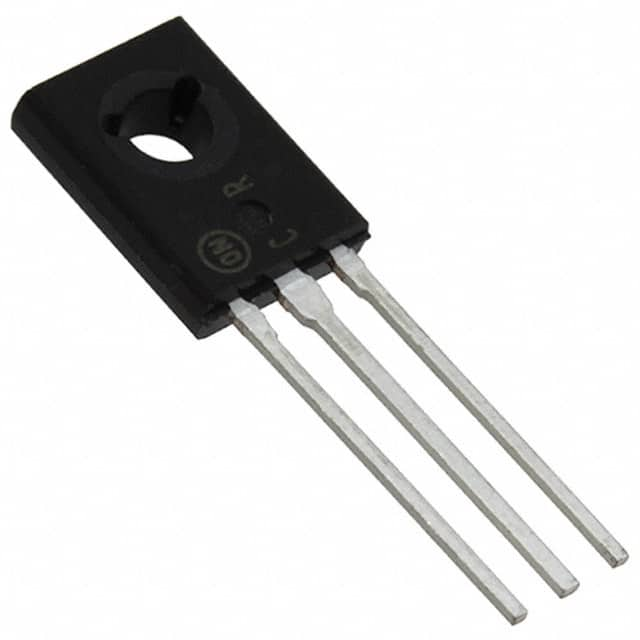Viz Specifikace pro podrobnosti o produktu.

BD677G Transistor: Encyclopedia Entry
Introduction
The BD677G transistor is a crucial component in electronic devices and circuits. This encyclopedia entry provides comprehensive information about the BD677G transistor, including its product category, basic overview, specifications, pin configuration, functional features, advantages and disadvantages, working principles, application field plans, and alternative models.
Product Category
The BD677G transistor belongs to the category of power transistors. It is specifically designed for high-voltage applications and is commonly used in power amplification and switching circuits.
Basic Information Overview
- Use: The BD677G transistor is primarily used for amplification and switching purposes in electronic circuits.
- Characteristics: It is characterized by its high voltage and current capabilities, making it suitable for power applications.
- Package: The transistor is typically available in a TO-126 package, which provides easy mounting and heat dissipation.
- Essence: The essence of the BD677G lies in its ability to handle high power levels while maintaining stability and reliability.
- Packaging/Quantity: It is commonly available in reels or tubes containing multiple units, depending on the manufacturer's packaging standards.
Specifications
The BD677G transistor has the following key specifications: - Maximum Collector-Emitter Voltage (VCEO): 45V - Maximum Collector-Base Voltage (VCBO): 45V - Maximum Emitter-Base Voltage (VEBO): 5V - Continuous Collector Current (IC): 4A - Total Power Dissipation (PTOT): 36W - Transition Frequency (fT): 2 MHz
Detailed Pin Configuration
The BD677G transistor has a standard pin configuration with three leads: collector, base, and emitter. The pinout configuration is as follows: - Collector (C) - Pin 1 - Base (B) - Pin 2 - Emitter (E) - Pin 3
Functional Features
The key functional features of the BD677G transistor include: - High voltage and current handling capability - Low saturation voltage - Fast switching speed - Good thermal stability
Advantages and Disadvantages
Advantages
- Suitable for high-power applications
- Robust construction for reliable performance
- Low saturation voltage minimizes power loss
- Fast switching speed enhances efficiency
Disadvantages
- Higher heat dissipation due to high power handling
- Limited frequency response compared to small-signal transistors
Working Principles
The BD677G operates based on the principles of bipolar junction transistors (BJTs). When a small signal is applied to the base terminal, it controls the larger current flow between the collector and emitter, allowing for amplification or switching functions.
Detailed Application Field Plans
The BD677G transistor finds extensive use in various applications, including: - Power amplifiers - Switching regulators - Motor control circuits - Audio amplifiers - LED drivers
Detailed and Complete Alternative Models
Some alternative models to the BD677G transistor include: - TIP31C - 2N3055 - MJ15003 - MJE13005
In conclusion, the BD677G transistor serves as a vital component in power electronics, offering high-voltage capabilities and robust performance. Its versatility and reliability make it a preferred choice for numerous electronic applications.
Word Count: 410
Seznam 10 běžných otázek a odpovědí souvisejících s aplikací BD677G v technických řešeních
What is the BD677G transistor used for?
- The BD677G is a PNP power transistor commonly used in high-power amplifier and switching applications.
What are the key specifications of the BD677G transistor?
- The BD677G has a maximum collector current of 4A, a maximum collector-emitter voltage of 45V, and a maximum power dissipation of 36W.
Can the BD677G be used for audio amplifier circuits?
- Yes, the BD677G is suitable for audio amplifier circuits due to its high power handling capabilities.
What are the typical operating conditions for the BD677G?
- The BD677G operates within a temperature range of -65°C to 150°C and is typically used in medium power linear and switching applications.
Is the BD677G suitable for motor control applications?
- Yes, the BD677G can be used in motor control applications due to its high current and voltage ratings.
What are the recommended complementary transistors for use with the BD677G?
- The BD676G is the complementary NPN transistor that is often used in conjunction with the BD677G in amplifier and switching circuits.
Does the BD677G require a heat sink for proper operation?
- Yes, due to its power dissipation characteristics, it is recommended to use a heat sink when operating the BD677G at high power levels.
Can the BD677G be used in automotive applications?
- Yes, the BD677G can be used in automotive applications where high power switching or amplification is required.
What are the typical failure modes of the BD677G?
- Common failure modes include thermal runaway under high load conditions and breakdown due to excessive voltage or current.
Are there any specific layout considerations when using the BD677G in a circuit?
- It is important to ensure proper heat dissipation and minimize parasitic inductance and capacitance in the layout when using the BD677G in a circuit.

